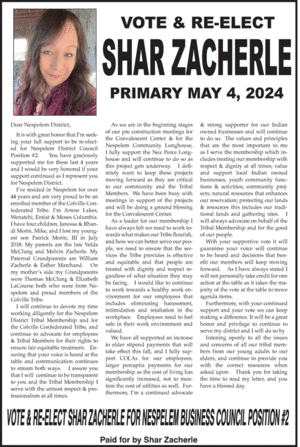CBH: Huge hydropower project now far more likely here
Six-year project could start in two, bringing in 1000-plus workers
Last updated 3/1/2021 at 3:52pm

A slide from a presentation given yesterday at the Lake Roosevelt Forum looks east from the project's upper intake area at North Dam and traces the route of the large pipes (dark shadowed lines) 350 feet beneath the surface from North Dam Park, underneath city of Grand Coulee, headed toward its lower intake area in Lake Roosevelt, just beyond the Crescent Bay boat launch within the are protected from boats by the float line barrier behind Grand Coulee Dam.
A proposed $1.4 billion hydropower project is looking more likely to happen in the area, its promoters say, and would bring in 1,000-1,500 workers during construction and create 100-150 permanent jobs.
The Banks Lake Pumped Storage Project would be a gravity-fed, pumped-storage system, draining water from Banks Lake, back down to Lake Roosevelt, turning generators in the process, and later pumping the water back up to Banks Lake.
One or two penstock pipes, up to 35 feet in diameter, would run 300 feet underground between the North Dam area on Banks Lake to Lake Roosevelt within the buoy line behind the Grand Coulee Dam.
The project, being developed by Columbia Basin Hydropower, is about 70% likely to happen, according to Tim Culbertson, manager of project development at CBH.
Culbertson told The Star in an interview by phone on Thursday that in 2016, when The Star last reported on the potential project, he would have estimated the likelihood of it being completed at less that 20%.
But changes in Washington state legislation related to energy have changed that outlook and increased the need for such a project.
"Pretty much all of the coal plants in the northwest are going through early decommissioning to be shutdown no later than 2030," Culbertson said, adding that utilities are no longer allowed to develop combustion turbines, which turn electric generators with power generated by fuel combustion.
"So there's a significant loss of what we call base-load generation in the region and most of that generation is being replaced ... with more intermittent generation, primarily wind and solar," he explained. "So the issue becomes for the region: what happens; where does the flexibility come from to back up these intermittent energy sources?"
Culbertson noted that for eight days, beginning on Halloween of this year, less than 1% of wind generation was online due to a lack of wind.
"What are you going to use as a resource to back up that generation?" he asked.
A gravity-feed system here would power two, 250-megawatt generating units, or 500 megawatts total.
Banks Lake and Lake Roosevelt currently operate to support 314 megawatts of pumped storage capacity, using Grand Coulee Dam's own pump-generating plant, the John W. Keyes III Pump Generating Plant.
Culbertson emphasized that one of CBH's primary goals is not to disrupt the goings-on of the town. He says that most of the work would be underground, and citizens would still be able to go to Safeway or drive around as normal, throughout the town because the construction would be far beneath the ground.
Holes would be dug at the intake locations at North Dam and at Lake Roosevelt behind the dam, and the tunnels would be dug simultaneously to meet in the middle.
But the earth bored out of where the pipes would go would have to go somewhere, which is one of the issues that would need to be solved before construction could begin.
Culbertson said engineering and planning would likely take another two years, with ground possibly being broken in 2022 and the project finishing in 2026.
Where the 1,000-1,500 estimated workers on the project would stay is another issue that would need resolving, noted Culbertson, who was set to present an update on the project yesterday to the Lake Roosevelt Forum's annual gathering at the Davenport Hotel in Spokane.
Yet another is the legislation currently proposed in Congress to make it easier. Currently, the project would be under joint jurisdiction of the Bureau of Reclamation and the Federal Energy Regulatory Commission. But if the legislation passes, FERC would no longer be in the picture, and CBH would then apply to the Bureau for a "Lease of Power Privilege."
An additional benefit to the community, Culberston said, would be that the privately owned project would pay into the tax base of the area, something the U.S. Bureau of Reclamation doesn't do.
"At this point in time, total project cost is estimated to be $1.4 billion," Culbertson said. "We are currently in discussion with a number of large potential investors."
CBH grew out of three irrigation districts in the Columbia Basin: East Columbia Basin Irrigation District, Quincy Columbia Basin Irrigation District and South Columbia Basin Irrigation District.
"CB Hydropower performs operation, maintenance, and administrative functions for five hydropower projects owned by the Districts - Main Canal Headworks, Summer Falls, Russell D. Smith, Eltopia Branch Canal, and Potholes East Canal," their website states, noting that power generated by those projects is purchased by the cities of Seattle and Tacoma.


Reader Comments(3)
SCOTT HUNTER writes:
Good info, Bob, thanks. Actually, the entire project is based on wind power's lack of generation at times, which seems to be propelling other forms of renewable energy, with storage, into a new role.
11/21/2019, 2:33 pm
Chuck Hickey writes:
I wonder how much change in depth would occur in Banks Lake. What could be the daily change? Would it make the Lake better for recreation? Would it affect Sport Fishing?
11/21/2019, 8:50 am
Bob VALEN writes:
The article seemed to wave off wind power's lack of generation at times. Yet, there are several examples addressing energy storage both here in the U.S. and abroad. Here's a link that is about the subject of energy storage. https://www.windpowerengineering.com/whats-new-in-energy-storage/
11/21/2019, 6:40 am